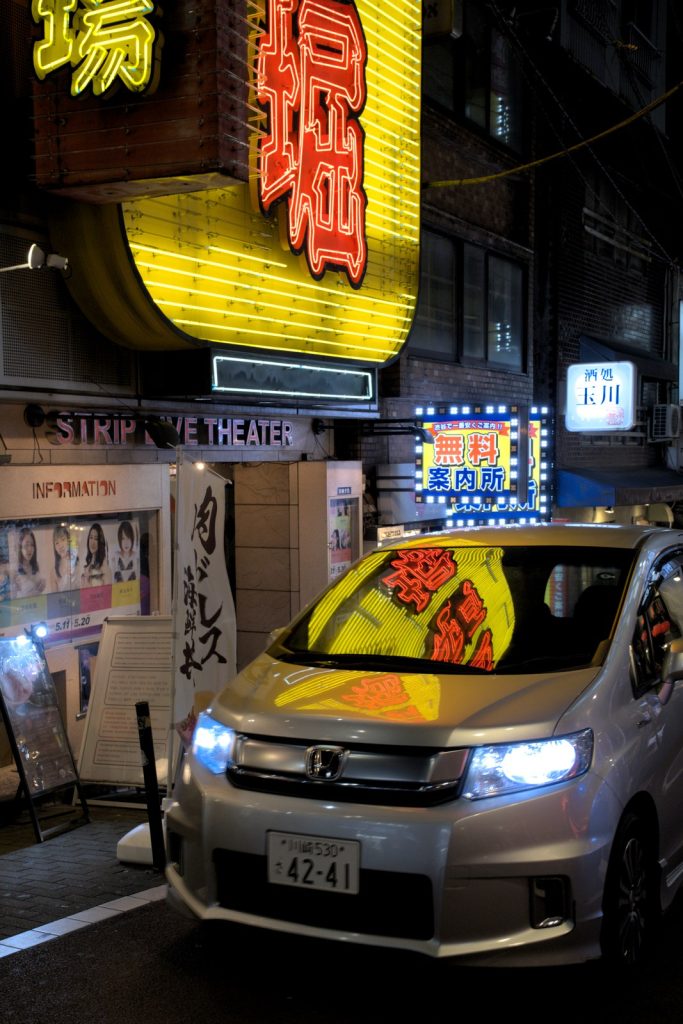I like to take photos, but I’m generally not that great; most of my photos are of my motorbike, my motorbike in front of stuff, or family snaps. I recently entertained the idea of getting a new camera body this year, but decided instead to upgrade my skillset a bit and invest in that instead. To that end I just went on my first Pro-led photo tour of Tokyo, and I loved it.
My goals were to learn and practice more about what I could do better, and how to better use my camera. I also wanted to see parts of Tokyo I knew, bits I didn’t know and obviously to get some nice shots.
An old friend of mine is a semi-pro photog and has been doing it commercially for years, so I hit him up, discussed what I wanted, he came up with a bit of a syllabus, and off we went for a three hour night shoot around the Tokyo districts of Shibuya and Shinjuku.
First off – manual mode. I don’t do manual mode – only auto or aperture priority – so this was already new territory for me, and do you know what? It really wasn’t that bad and completely addressed one thought I’d had in Japan (especially Tokyo) about how to shoot cityscapes at night and getting the dynamic range for neon and darkness, and as Ivan showed me, knowing how to use manual mode goes a long way to getting these shots and quite a few other shots where I’d probably try auto and be disappointed at lights levels.
Do not fear the manual mode.
We also spent time looking at composition, not just the well known guides/rules, but also implementing them in a street photography setting; why some things worked, why others didn’t and what settings did in these scenarios.
Ivan knows a lot of great places for testing these skills too, as well as etiquette for being around people and taking photos. Fortunately we were in well trafficked public places where people are either tourists, or people are too busy going about their lives to worry about some incompetent man fiddling with his shutter speed setting. It’s also good to know how not to distract people who you may want in a composition.
One thing I hadn’t fully appreciated for a photo walk was the sheer amount of walking involved, going from one cool location to another, but also the minor movements required to get a shot from the specific angle you want. I’d never thought about the need for waiting for the timing of the large screens and neon to be lit correctly either – I would have snapped and moved on. We also made some use of our time waiting for trains, taking respectful shots of them, passengers waiting and framing travellers in doorways. Technically this is something I’ve seen thousands of times, but I never thought to take a photograph, so that was great.
Another skill we worked on was panning, so your subject appears frozen and the world is moving around it. This was difficult for a couple of reasons for me – turning at the speed of your subject, nailing focus as best your camera can isn’t the easiest skill to learn. This was also the first time I’d encountered the issue that my camera’s buffer is pretty small – it’ll do about 12 frames, and I was panning at 8fps. Once the buffer fills, it basically stops, then spends about 10 seconds draining that data to the SD card before you can use it again. This is the part of camera reviews I usually tune out.
Practically, this means I have fewer chances to get the shot, and then I have to wait for camera, and then for traffic to be flowing how I need it again for another try. Does this mean I need a new camera? No, it means I need to get better at nailing the panned shot in fewer attempts.
Overall, it was a great experience, and when I got home and copied all the shots of the evenings photos to my PC in digiKam (over 350 RAW files), I was actually really impressed by what I’d got – some of them are the kind of photos I see other people getting, but I never got near, but this time I was definitely on the right track. I was a bit concerned I’d forget what I’d learned, but looking at the photos I could easily remember why it was at that shutter speed, or why the composition was how it was, so hopefully I can continue shooting manual mode more often and develop these into habits and skills.
To see what Ivan’s up to have a look at his photo website. As you’d expect, any good things in these photos are likely through Ivan’s guidance, and where not, well that’s where I need to improve.
My setup for the night: Fujifilm X-T200, 23mm prime, 16-80mm, borrowed 16mm prime, borrowed zoom telephoto, my cheap old tripod, a spare battery, a spare SD card, comfy shoes.



















